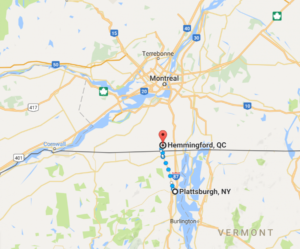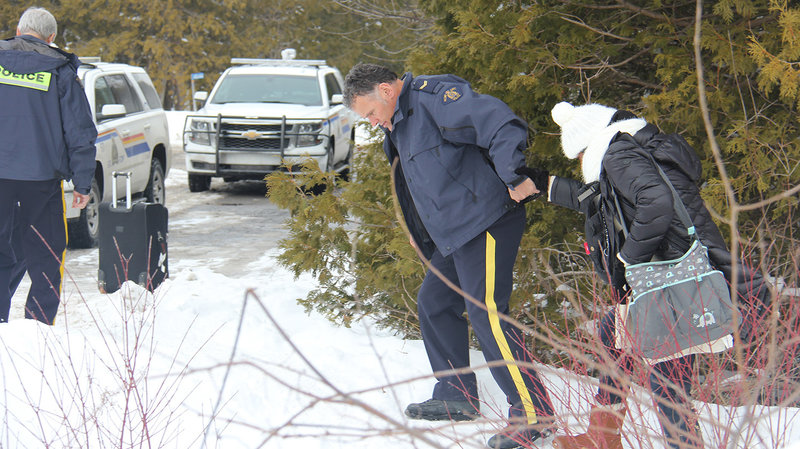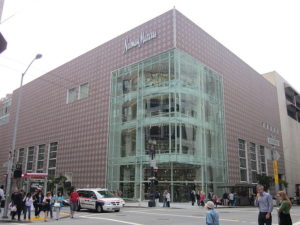The stark contrast in U.S.-Canadian immigration policy and American priorities avowed by President Trump has lead to a surge of refugees crossing from the U.S. into Canada.
Driven by fears of what Trump’s presidency will mean for refugees, a growing number of asylum seekers are braving freezing cold temperatures—ranging from minus 30 to minus 40 during the winter—to walk into Canada from the U.S. The Royal Canadian Mounted Police say they’ve seen a spike in illegal immigration to Canada in the month since Trump has been in office. According to Canada Border Services Agency, this past year, 1,222 people entered Quebec illegally and requested refugee status – almost five times the total in the previous year. Most have walked across the unfenced, minimally patrolled, open border. Sometimes they’re dragging suitcases. Often they’re wearing clothes that offer little protection from the freezing temperatures.

A graph representing the jump in immigration into Canada over the recent months since Trump’s election. Graph courtesy of Canada Border Services Agency.
In an interview with Public Radio International, Paul Caulford, a doctor at the Canadian Centre for Refugee and Immigrant Health Care outside Toronto, said, “There’s no question what’s driving them. Virtually every person who’s crossed into Canada from the U.S., from pregnant women in the back of trucks to those on foot shepherding their children to safety, have said to us that the U.S. is no longer a safe country for them to be in.”
Caulford is referring to President Donald Trump’s far-reaching plan to enforce the nation’s immigration laws more aggressively by unleashing the full force of the federal government to find, arrest and deport vast numbers of undocumented immigrants, regardless of whether they have committed serious crimes.
According to the data released by the Canada Border Services Agency, the asylum-seekers walking across Quebec’s border illegally are a mix of US citizens, green card holders and other groups that are from Eritrea, Somalia, Ghana, Nigeria, Burundi, Syria, Sudan, Yemen and countries facing economic or war catastrophe.

A Canadian police officer offers a hand to a migrant crossing the US-Canadian border near Champlain, NY. The Royal Canadian Mounted Police are reporting surges in illegal crossings into Canada in recent months. Photo courtesy of Vermont Public Radio.
Why are refugees crossing the Canadian border illegally and not through a Canadian border crossing?
Many of these immigrants had their eyes set on America. “They made their claims, or were planning to make their claims to asylum, in the US,” Caulford says. “And they have learned very quickly from the media that the US is now a changed nation.”
Undocumented immigrants in the US, estimated at 11 million, are particularly vulnerable to Trump’s presidency. This is supported by the immigration and refugee clinical program at Harvard Law School which issued a report stating that Mr. Trump’s executive orders on immigration made the United States “not a safe country of asylum” for people fleeing persecution and violence. People who work with immigrants in Canada say these border-jumpers would rather be arrested in Canada than live in fear of how US officials might handle their cases.
These families aren’t using the regular routes into Canada, through an official border crossing, because of an agreement between Canada and the US. According to the 2004 CanadaUS Safe Third Country Agreement, a person who is in the US, which is considered a “safe” country, cannot request admittance as a refugee into Canada.
However, there’s a loophole. If there’s no record of a family crossing the US-Canada border, and they just show up in Canada, the family can apply for refugee status. If they request refugee status when they’re already on Canadian soil, and pass a criminal check, their case will be considered. So Caulford says migrants pay what they call “agents” to smuggle them across the border.
Now, in light of the uncertainty and disruption created by President Trump’s executive order on immigration, human rights groups and refugee advocates in Canada are demanding that Prime Minister Justin Trudeau led government cancel the US-Canada refugee pact. Proponents argue that pulling out of the Safe Third Country Agreement would make it easier and safer to cross legally, and eliminate the market from guides or smugglers taking advantage of the migrants.

Migrants were spotted with luggage marked with Plattsburgh, NY, an airport near the Quebec border. Photo courtesy of Google Maps.
After they’re caught, the migrants request to be admitted into Canada as refugees. Canadian Mounties arrest those who cross the border illegally, but can only detain them for up to 24 hours before either releasing them or presenting them in front of a judge.
“Once that we do all our checks and that we can confirm that they’re not a threat to national security, we hand them over to [the Canadian Border Service Agency] who then start the immigration process,” says Cpl. Camille Habel, spokeswoman with the Royal Canadian Mounted Police in an interview with NPR on February 17th.
They receive a date to appear before a refugee tribunal, which by law cannot be more that two months away. Additionally, unlike in the US, they don’t have to wait in detention centers for that court date to come. On average 60 percent of all people who go before the tribunal are granted asylum in Canada, although the acceptance rate varies by country of origin, says Melissa Anderson, the spokeswoman for the Immigration and Refugee Board of Canada.
It’s hard in the US — and it might get tougher to get refugee status, under Trump’s new executive orders. The more the US turns people away, the more Canada will feel it. Whatever the case may be, there is no talk in Canada about building a wall on the American border—as Canada has not wrestled with the wave of xenophobic, anti-immigrant nativism that erupted in the US and Europe. Canadians continue to see immigration as critical to their economic success and have already invited in so many immigrants that today, one-fifth of the population is foreign born.
These recent events brings up the question if the most American motto — E pluribus unum — out of many, one — has moved north.
Timeline of Trump’s executive orders on immigration and travel bans and initial legal backlash:
On January 26th, Trump signed an executive order that indefinitely suspended refugees fleeing war-torn Syria, and barred nearly all travelers from seven Muslim-majority countries—Iran, Iraq, Syria, Sudan, Somalia, Libya and Yemen—for 90 days and blocked refugees for 120 days, this executive action immediately caused chaos amongst refugees who had secured visas and were about to transit into the U.S. Also impacted were those with green cards who were temporarily abroad and needed to get home.
In immediate response to the Trump administration’s travel ban, world leaders and other prominent figures such as German Chancellor Angela Merkel and British Foreign Secretary Boris Johnson have blasted Trump’s ban as divisive, illegal, insulting and discriminatory.
In the U.S., on January 28th, a federal judge in Brooklyn, New York signed an order, stopping the deportation of travelers caught in the ban and ordering the release of travelers with valid visas.
The Department of Homeland Security responded on January 29th by reacting to the conflagration Trump’s order had instigated by granting an exception to green card holders. Others, however, were still banned and many were left in limbo in transit, stuck in airports all over the world.
On January 30th, the first lawsuit was filed in federal court by the Attorney General of the state of Washington asking for a restraining order to block Trump’s edict. Four additional states and multiple individual plaintiffs sued Trump over the ban and by February 10th, there were roughly 20 lawsuits trying to stop the ban. President Trump’s Twitter account, @realDonaldTrump, responded with “See you in court, the security of our nation is at stake!”
On February 20th. the Department of Homeland Security issued two memorandums outlining how the agency intends to implement and enforce Trump immigration policies. The memos reveal the broad scope of president Trump’s ambitions: to publicize crimes by undocumented immigrants; strip such immigrants of privacy protections; enlist local police officers as enforcers; erect new detention facilities; discourage asylum seekers; and, ultimately, speed up deportations.
Under the new directives, the government “no longer will exempt classes or categories of removable aliens from potential enforcement.” Immigration agents can now focus on picking up and removing anyone suspected of committing, charged with or convicted of any criminal offense, even minor ones, as well as anyone already ordered deported, regardless of whether they have a criminal record.
The new edicts are more draconian than Trump’s original travel ban. One month later, both immigrants who are undocumented and documented in the US are besieged by fear and have cancelled legal government services—for which they are due. They are trying to lower their profile and hide from I.C.E.
The new enforcement policies put into practice language that Mr. Trump used on the campaign trail, vastly expanding the definition of “criminal aliens” and inflaming white fears by alleging that such unauthorized immigrants “routinely victimize Americans,” disregard the “rule of law and pose a threat” to people in communities across the United States.







